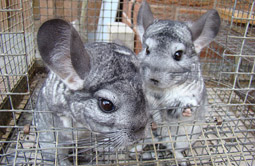Chinchillas living on farms
Breeding females are housed individually, in wire cages. These cages have a surface of 0,14 to 0,5 m² and are usually 35 to 40 cm high. The cage floor and walls are wire mesh. Sometimes, the floors are also partially made out of wood. Feces falls into trays below the cages. The cages are stapled on top of one another, sometimes 3 to 5 cages high. This allows for up to 60 chinchillas to be held on a surface of only 10 m².
Corridors connect the individual cages. The males are held in the corridors. They have access to 4 to 10 females via openings in the individual cages. In order to prevent the females from fleeing from their cages, they are fitted with high plastic collars. Once a female is pregnant, access to its cage is shut down. 6 to 8 weeks after the female litters, access to her cage will be ensured once again. Until they are slaughtered, the young are held in wire frame or chicken wire cages that are only 40 x 40 x 40 cm.
For an animal that, in the wild, would hop around incessantly, these low cages are an intolerable restriction. When chinchillas are frightened, their reaction is to jump, which makes them hit the roof of the cage. They thus often injure themselves. They are fed only dry food. The young animals often have difficulties swallowing these pellets which are not ideal for the grown animals either, because their digestive system requires fresh fruit and vegetables.
The male animals that live in the corridors between the cages often do not have their own water and food bowls and are forced to use those of the female animals. This often leads to fights and to bite wounds. On farms, you therefore often see chinchilla with injured or missing ears, eyes, or tails. The cramped housing and the forced social structure lead to behavioral disturbances. Often, the animals gnaw off their own fur or the fur of other animals.
The cages are rarely equipped with nesting boxes and are only rarely laid out with straw. The nocturnal and shy chinchilla have no possibility to withdraw from other animals and from humans. Furthermore, work on the farm and with the animals is carried out during the day. This is tremendously stressful for the nocturnal chinchillas. Often, the animals also have no possibility to sand bathe. A scientific study showed that, given access to sand for 4 hours every day, the chinchillas used most of this time to sand bathe. This demonstrated clearly that chinchillas have an elementary need to care for their fur in this manner.
Chinchillas are very difficult to breed on farms. Female animals in the wild have litters of up to 6 young once or twice a year. In farms worldwide, females have an average of 2.2 young a year. Furthermore, only approx. 26% of the pairings prove to be successful. One of the reasons for this is that the females are not allowed to choose their mates. After littering, it is essential for the female’s survival that she be able to eat the placenta with its vital nutrients that will sustain her through the period of suckling of the young. Often, however, in cages, the placenta falls through the floor of the wire cage and becomes inaccessible to the female. In addition to this, the mortality rate of the young is extremely high on farms, often induced by infections, which leads to an adverse survivability.
A long wait for death

CAUTION!
The following film demonstrate hard facts and therefore may not be suited for everyone!
Chinchilla farms
Additional information
-
The «Humane Society of the United States» and its Fur free campaign.
-
The Canadian environmental protection organization «Global Action Network» and its extensive anti-fur campaign.
